Personal project
Project
Charity project
platform
Design website and responsive webs
My work to comeplete
Proceed to develop the entire design process for the project. From analyzing problem spaces, conducting research, brainstorming, sketching low-fidelity drafts to creating high-fidelity prototypes, and evaluating usability. The main focus is on UX strategy.
Completion time
4 months
overview
The application connects kind-hearted individuals to join hands in helping those facing difficulties in life. It addresses issues of transparency in fundraising for charitable purposes, preventing financial losses and misuse by malicious actors.
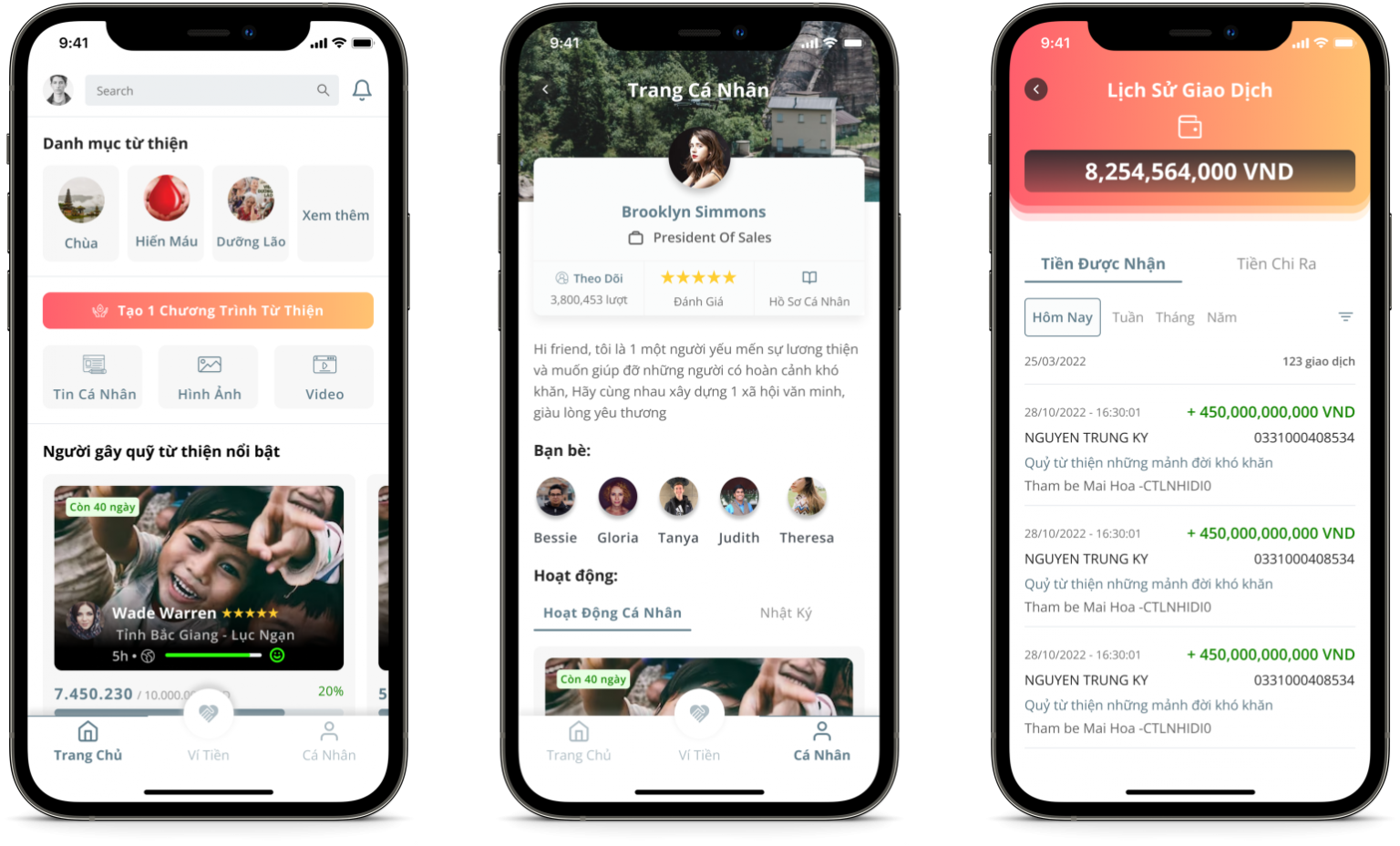
Overview
1. The context
- During the period 2021-2025, it is estimated that the multidimensional poverty rate will be around 9.3%, corresponding to 2.5 million households with 10 million poor people; the near-poor household rate will be approximately 7%, corresponding to 1.89 million households with 7.61 million near-poor people.
- They are individuals with low incomes, at the bottom of society, struggling to secure daily meals and living in poor conditions that adversely affect their health.
- The reasons for their situation include lack of housing, forced exploitation, confiscation, debt bondage, mortgage, abusive and violent behavior, unemployment, and natural disasters.
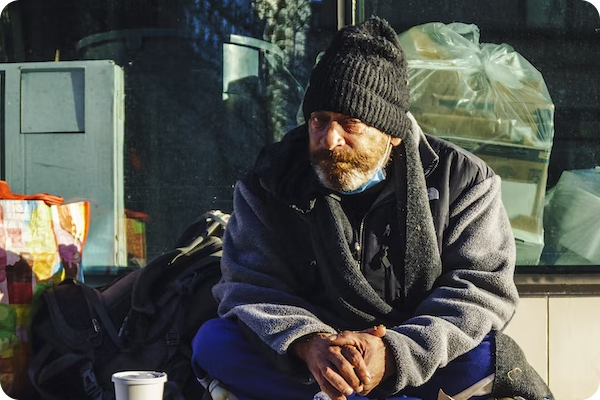
1. Bối cảnh
2. The Current State of Social Charity Activities in Vietnam Today
a. Positive
Charitable activities in Vietnam are primarily organized by: the Central Committee of the Vietnam Fatherland Front, the Central Committee of the Vietnam Women’s Union, the Red Cross Society, and the Compassion Fund… In addition, there is widespread participation from businesses, singers, sports stars, actors, and others. They provide material support, contribute to building schools, offer scholarships to underprivileged children… These are some of the positive aspects seen today.
b. Negative
- The primary reason still lies with the State, which has not truly encouraged the development of charitable activities by individuals, non-state organizations, and non-profit entities.
The laxity and lack of state control over charitable activities have led to a situation where many singers and actors call for donations. Notably, these individuals and organizations raising funds do not establish funds in accordance with the regulations stipulated in Decree No. 93/2019/ND-CP on the organization and operation of social and charitable funds. Instead, they request donations to be deposited into personal or organizational accounts.
Additionally, there is mismanagement of relief funds and goods, with instances of public officials embezzling resources for personal gain and falsifying lists of recipients for relief money and goods.
=> From the aforementioned issues, we need a solution to thoroughly address these problems, which is a social network application dedicated to charitable activities. It will help the State minimize risks, as well as make charity appeals by individuals more transparent and clear. The application includes two main user groups:
- Businesses, singers, sports stars, actors… (primary users)
- Kind-hearted individuals who want to contribute and lend a hand (secondary users)
Charity project
Design process
- Bước 1: people problem
- Pain point
- User goal & motivation
- User needs
- Solutions
- Bước 2: user research
- Interview process
- Goal
- Interview
- Interview Protocol
- Results obtained from the affinity diagram
- Summary of research findings
- List some trends identified
- User persona
- Interview process
- Bước 3: Design alternatives
- Brainstorming.
- Protocol (application for participants, timeline, rules, etc.)
- HMW
- Opportunity Space
- Solution
- Conclusion
- Preliminary Evaluation of Ideas
- Analyze ideas based on the impact-effort chart
- Key functionalities to be developed
- Low fidelity prototype
- Bước 4: Usability evaluation
- Usability inspection
- USABILITY HEURISTICS
- Cognitive walkthrough
- Usability testing
- Usability inspection
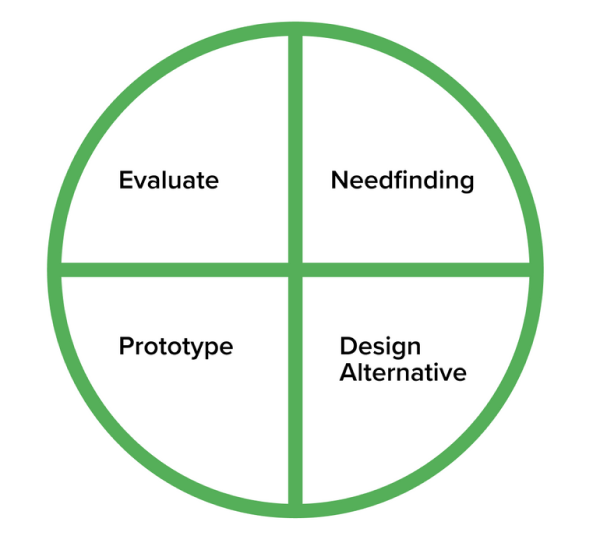
People problem
I will focus solely on the primary user.
Pain point:
- They can easily lose trust when investing effort and time to care for and help the homeless or those in need, due to some individuals who act without reason or intentionally provoke (such as embezzling donated funds, lack of transparency in financial records, etc.).
- They have to sacrifice their work and time, which could have been spent on their families, to support the people.
- If the documentation or charitable information is unclear, when it reaches the people, they will lose their reputation and face severe public criticism, which could harm their careers.
- They feel disappointed because doing good deeds goes unappreciated, and gradually, they will stop caring altogether.
User needs:
- From the perspective of the people, ordinary citizens must have trust and support for them, joining hands to contribute both assets and efforts.
- They are willing to spend their wealth and valuable resources to help these individuals, but due to the need for transparency in accounting or legal matters, they face difficulties. They need a perfect solution to help them manage these issues and ensure transparency, gaining public recognition.
- There must be strict penalties for those who are uninformed, act without reason, or intentionally cause harm to Primary users (fairness must be ensured).
User goal & motivation:
- Homeless people no longer have to struggle with a life full of hardships; they will feel happy and grateful toward the primary user.
- They no longer fear being exploited or facing social violence (such as children being exploited for begging or homeless children being abused).
- They will respect and wholeheartedly trust, dedicating themselves to helping the country as well as spreading love to build a developed and hunger-free nation.
user research
Goals
- What do you think about the current trend of charity appeals, where those who call for donations and supporters help people in difficult circumstances?
- The goal is to find out whether people care about charity or not.
- I want to understand the current state of charity work.
- What are the advantages or disadvantages of charity work?
- Do people trust that celebrities (primary users) will support them when they call for charity donations?
Interviewer (demographic)
- Age range: 25 – 60 years old
- Location: Primarily living in major cities such as Hanoi and Ho Chi Minh City
- Characteristics: People who care about charity work and volunteering, and expect those contributing to charity to be ethical, transparent, and clear in their actions.
Interview Protocol
- Location: A coffee shop in Ho Chi Minh City
- Introduction: Today’s interview topic
- Warm-up: Talk about life and friends you haven’t seen in a while to create a comfortable atmosphere before diving into the main topic.
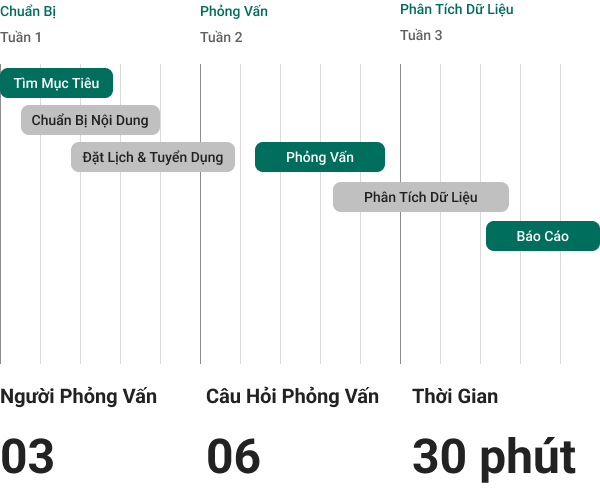
The results obtained from the affinity diagram include the following 7 groups:
- Inner self
- Charity methods
- Sharing charity issues with the community
- Charity status
- Issues with celebrities donating
- Dissatisfaction with celebrities’ charity efforts
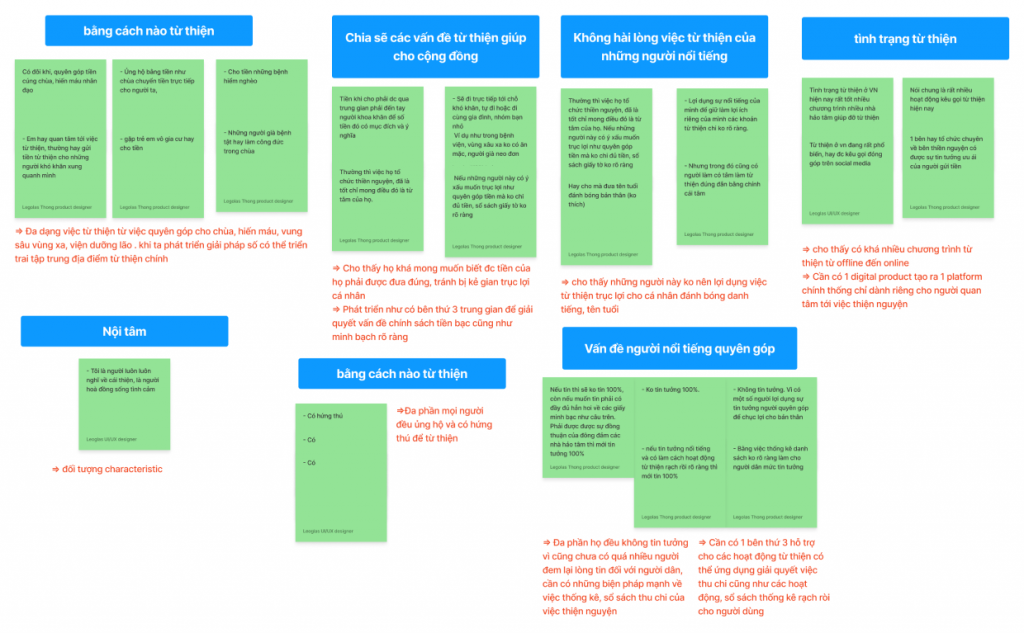
Summary of research results
1. List some trends found:
- Everyone is interested in and enjoys charitable activities.
- They always think about goodness and live harmoniously with compassion.
- Diverse charitable activities such as temple donations, blood donation, supporting remote and mountainous areas, and helping elderly people living alone.
- If building an application, it should include a suggestion feature based on the type of charity the user wants to participate in, through the options provided above.
- They want money, trust, and relief aid to be contributed correctly and transparently.
- There will be a third party to manage statistics, records, and ensure transparent and clear activities.
- Dissatisfaction with celebrities.
- Personal gain.
- Money, building a reputation…
- Personal gain.
- Charity activities, both offline and online, are quite diverse.
- Online activities are mainly conducted through social media.
- Why not develop a dedicated social media app for charity?
- Online activities are mainly conducted through social media.
- Most people do not trust because there are not many entities that have earned their confidence.
- There needs to be a third party approved by the authorities to ensure reliability and credibility.
2. Describe the research results
Based on the collected data, we have identified two types of user personas as follows:
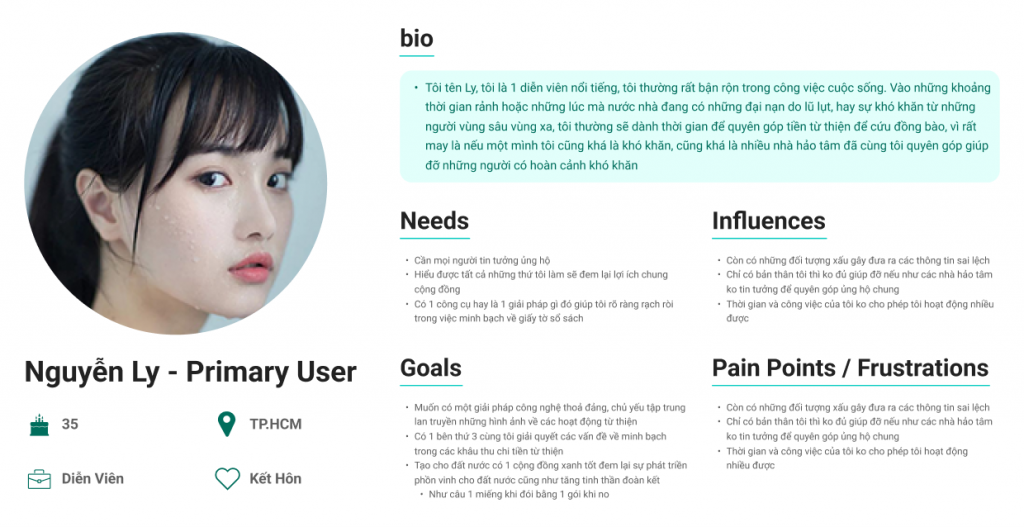
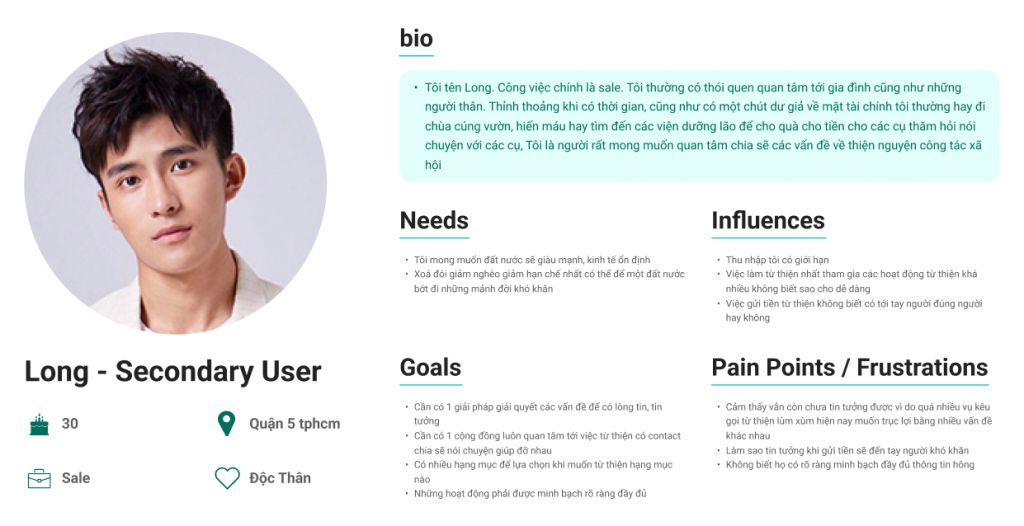
3. Conclusion
Qua công trình nghiên cứu này tôi đã tìm ra một số vấn đề cần giải quyết:
- Diverse charitable methods such as nursing homes, support for remote areas, blood donation, etc. Depending on the target groups, they require specific charitable approaches that align with their needs.
- Malicious individuals spreading false information for personal gain.
- Everyone desires to build mutual trust in charitable activities.
- There is a need for a third party to address issues related to transparency, legal compliance, and clear statistics, helping to establish trust between those who call for donations and those who contribute (through a charity-focused application or website).
Design alternatives
1. Brainstorming
Goals
- Identify solutions to the problem at this stage to develop preliminary ideas for creating a low-fidelity prototype.
Prepare a Brainstorming session
- Preparing a brainstorming session helps us generate many ideas by leveraging the thoughts of the participants.
The problem to be solved
- What makes you feel challenged when sending money to a celebrity (primary user) for charitable activities?

Conclusions
- Three opportunity spaces:
- Trust (Bảo)
- Reporting (Thúy)
- Program scalability (Thúy)
6 solutions:
- Transfer money through intermediary systems (2)
- The host has never received negative evaluations (1)
- Review the detailed plan of the fundraiser (1)
- Check the timeline of historical activities
- Good communication (2)
- Website, app, detailed report information…
- Have a website to retrieve information for each program (1)
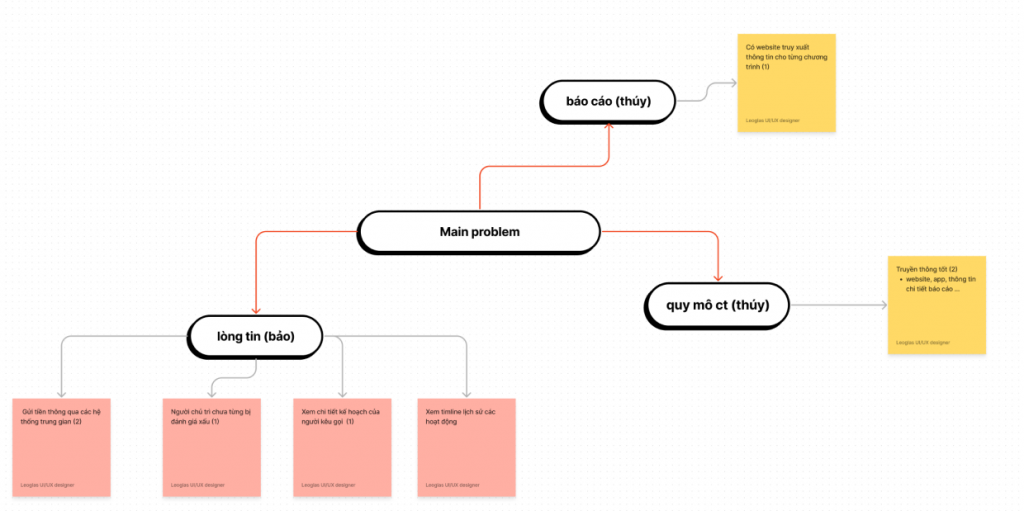
2. Preliminary evaluation of the idea
Analyze the idea based on feasibility and impact.
- Create an impact-effort chart
- Provide priority functions to build a low-fidelity prototype
Main function
- View the details of the charity fundraiser’s plan.
- View the timeline of historical activities.
- Send money through intermediary systems.
- Have a website or app.
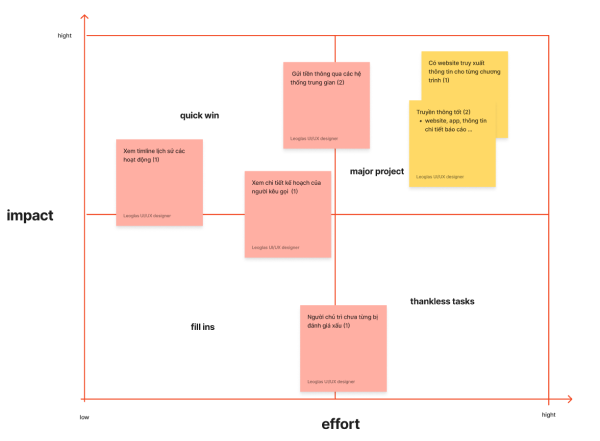
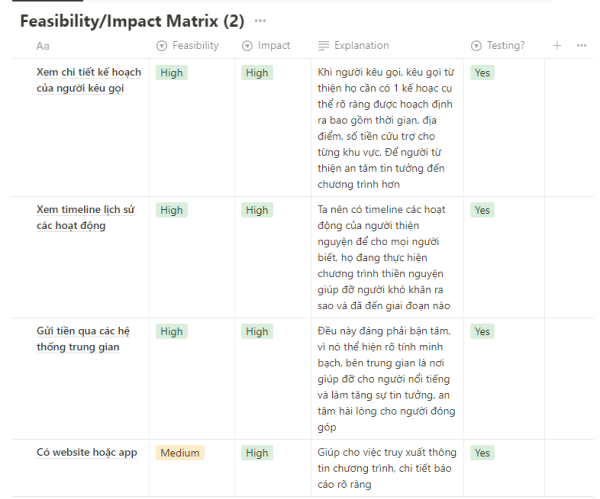
Low fidelity prototype:
- The direction is to develop a social media application designed to connect celebrities (primary users) and individuals interested in volunteering (secondary users).
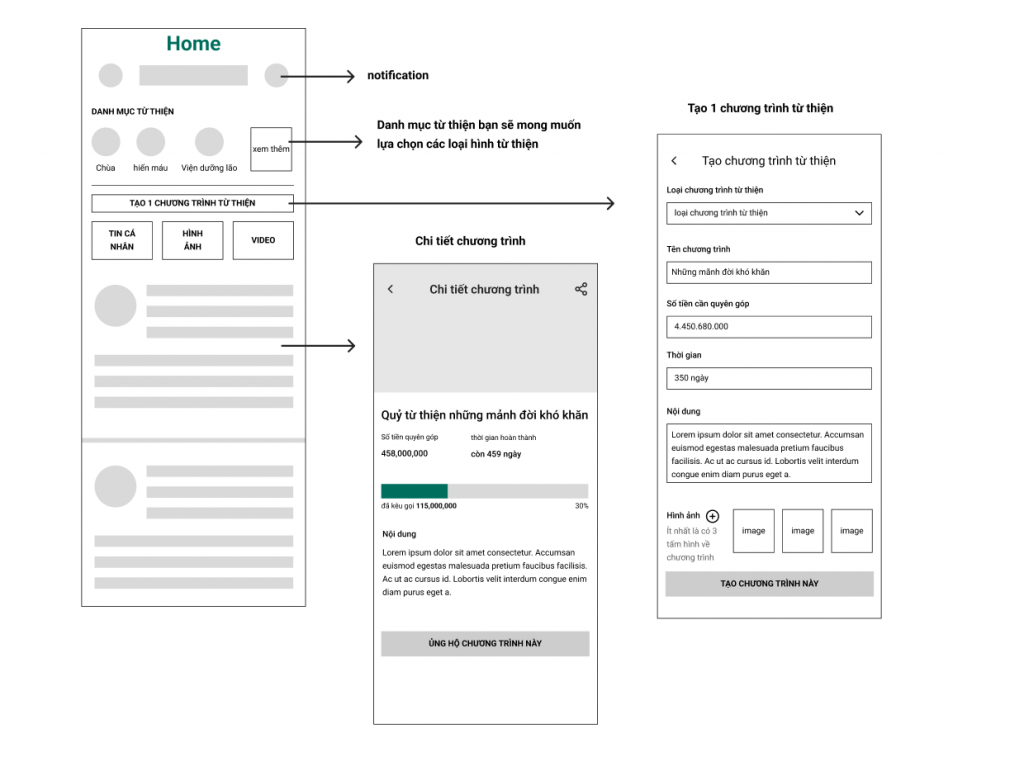
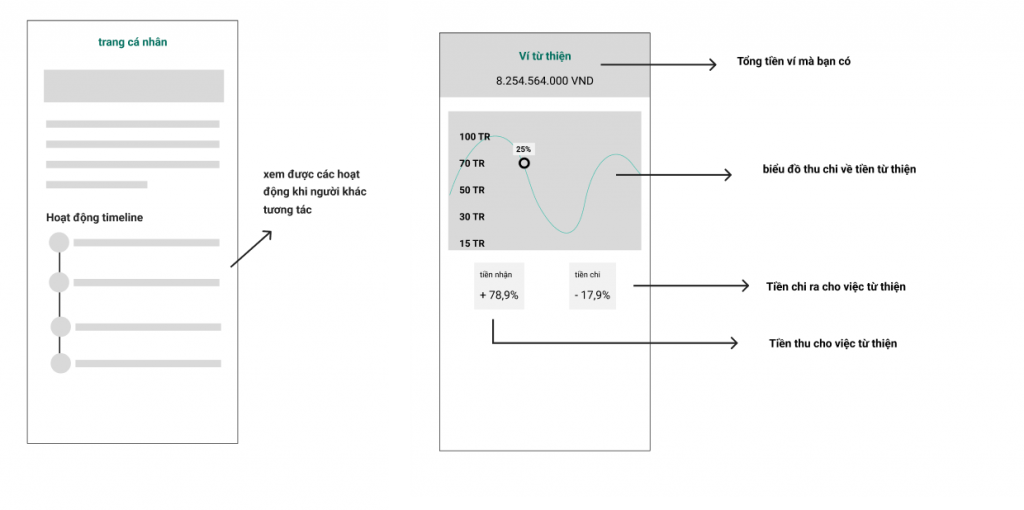
Usability Evaluation
The Usability inspection applies two common methods:
- USABILITY HEURISTICS
- COGNITIVE WALTHROUGH
=> To avoid limiting errors during usability testing with users, we will apply these two methods to improve the design as much as possible.
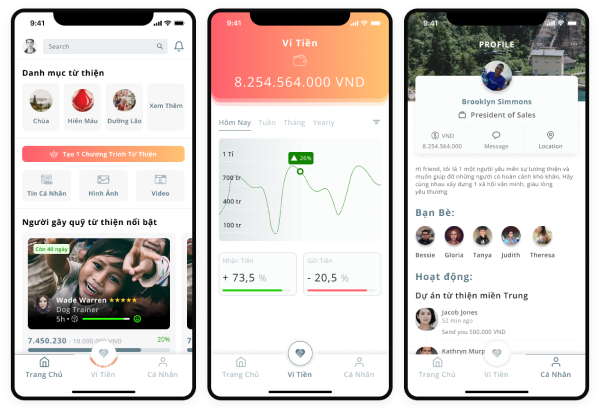
1. USABILITY HEURISTICS:
The application of USABILITY HEURISTICS helps improve designs in the following ways:
Visibility of system status
- The search feature, when typing, will help improve the user’s cognitive load by suggesting results, so they don’t have to remember everything on their own.
- For example: when typing a character, suggestions will appear below.
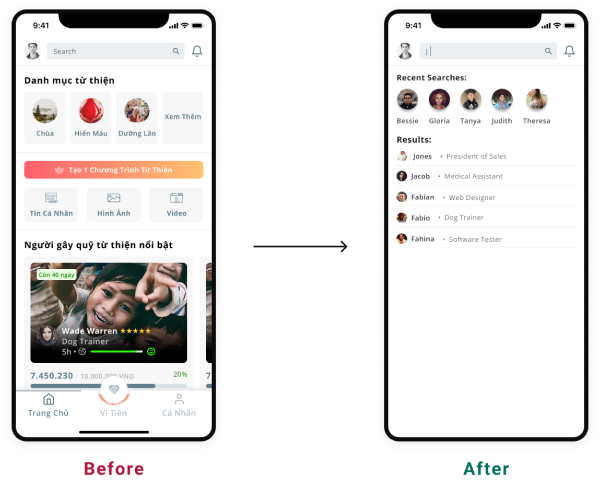
Flexibility And Efficiency of Use
- Improvements in the wallet section will include additional options for quick tracking of today, week, month, year, or more detailed views by selecting filters, allowing users to flexibly choose the time frame for the data they wish to view.
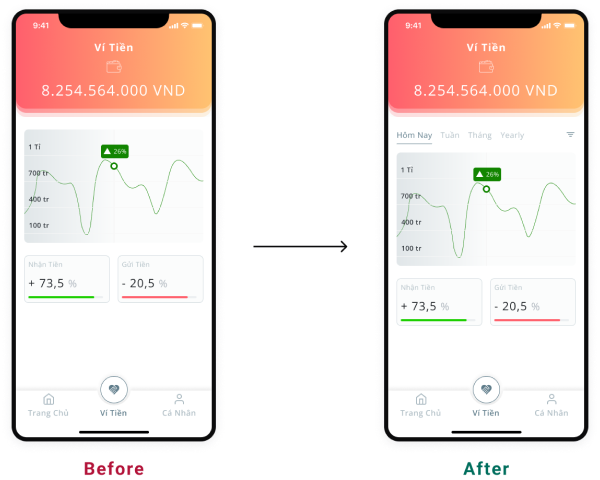
2. Cognitive walkthrough:
Applying the Cognitive Walkthrough helps improve a task that you want users to perform. Here, I will apply it to the process of making a charitable donation from the user’s perspective. Let’s take a look at some improvements when applying this method:
Step 1:
- We can see that when designing, we often overlook certain aspects. For instance, if there is no input data, we cannot click on the call to action, and it must remain in an empty state.
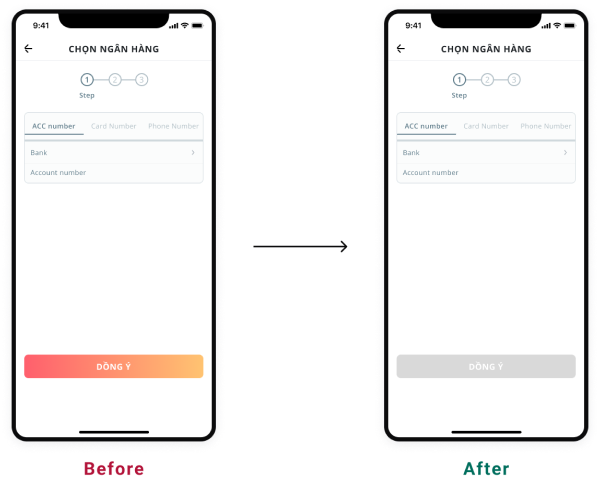
Step 2:
- On these screens, to prevent users from misunderstanding their errors, there should be a notification prompting them to provide complete information if they enter insufficient details. Additionally, if they enter an incorrect account or activation code, a pop-up will be shown to inform them that they have made an error and need to re-enter the information.
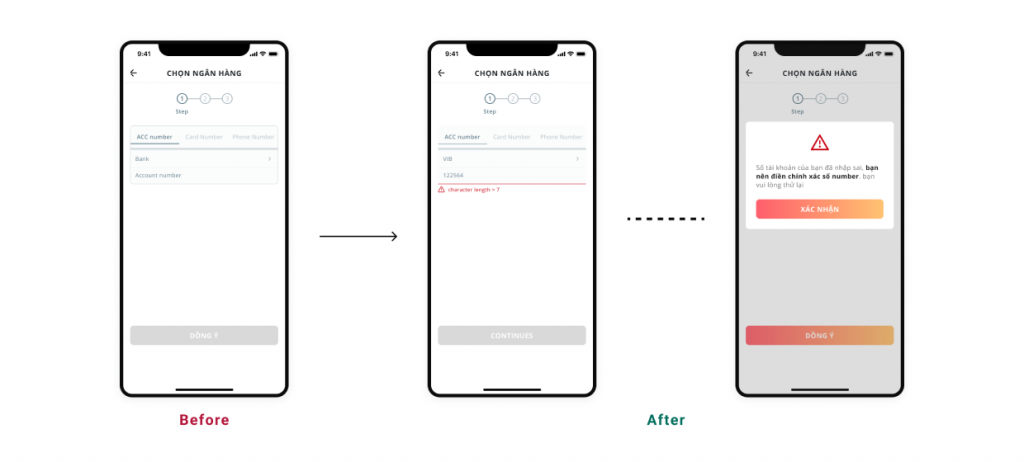
3. Usability testing:
Goals
- I will explore whether the charity application is stable yet and if there is anything that needs further improvement.
- When going through the donation process, do users find it easy to use and does it meet the expected time frame?
Interviewer (Demographic)
- Age: 25 – 40 years old
- Location: Living in Ho Chi Minh City
- Characteristics: Individuals interested in charity and volunteer work, with experience in various forms of charitable activities. They have a good understanding of technology, such as using financial apps, websites, e-commerce platforms, etc.
Usability testing protocol
- Location: offline, online
- Introduction: The topic you explore is about a charity app
- Warm-up: Catching up with friends after a long time apart creates a comfortable atmosphere before diving into the main topic.

The wallet after being improved:
- Completely redesigned interface with added withdrawal feature
- Transaction history and total charitable funds
- “More” icon for linking bank accounts
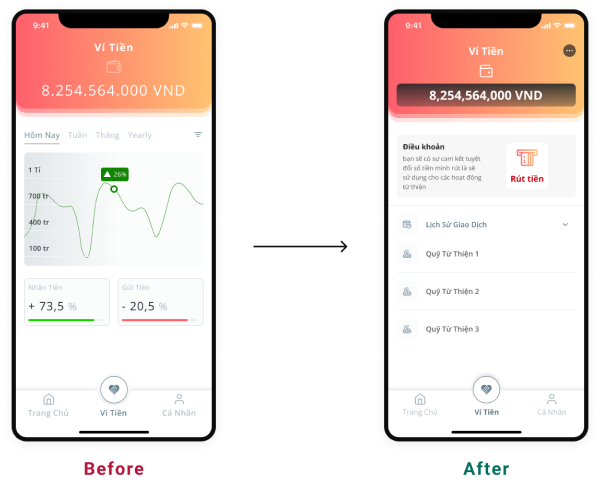
Charity Fund Details
- Add a progress bar to easily track how much of the fund has been raised
- Poster Information:
- Number of donations
- Number of funded projects
- Time and location
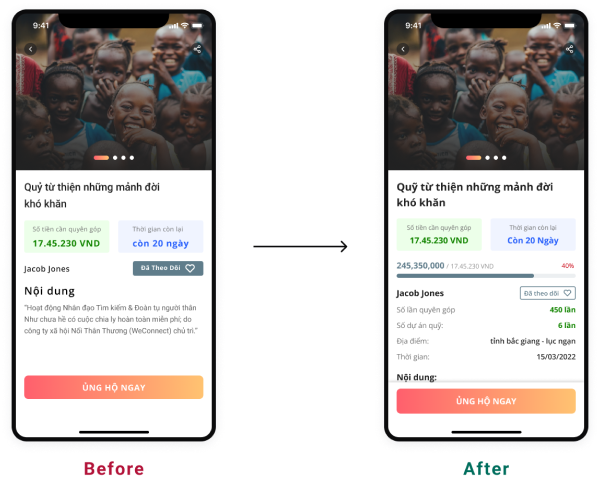
The transaction section for money transfers has been significantly improved:
- Removed the bank linking section from the profile and wallet.
- Added a tip field to help support the app’s operations, as this is a non-profit application.
- Confirmation of information will also be clearer, including displaying the total amount and recipient details.
- Added an OTP page for final verification.

Add some additional screens during the update from testing:
- Transaction history details
- Personal information for better authentication and security
- Additional screen for withdrawal terms
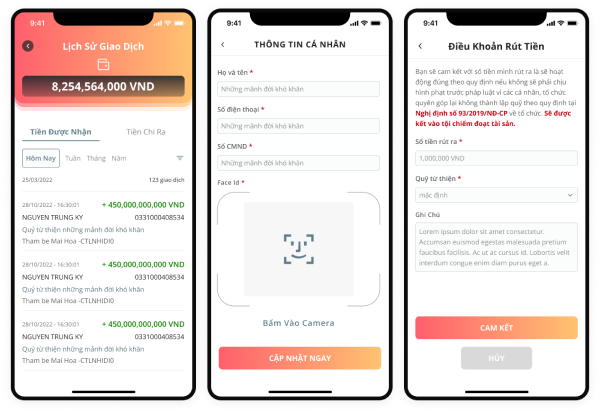
3. Conclusion:
Through conducting usability testing for both of the following methods:
- USABILITY HEURISTICS and Cognitive Walkthrough:
- Improved the initial design process, enhanced understanding of the software system’s operational state, and helped us build a system that avoids many mistakes when testing directly with users.
- USABILITY TESTING:
- It became clear that testing with users allows us to uncover issues that we might not be aware of during the design phase.
- Discovered numerous problems. This direct user testing led me to almost redesign a significant portion of the entire application, identifying and resolving critical issues.
lesson learned
Mục tiêu của case study
- Through research, it is understood that charity work in Vietnam still faces many issues that need to be thoroughly addressed. It can be transformed into digital technology to solve current challenges in charity work, such as lack of transparency and clarity.
- Understand the process of building a comprehensive product design workflow.
- From analyzing initial problems to conducting research to identify key issues.
- Learn how to brainstorm, use HMW (How Might We) to generate multiple ideas, and create low-fidelity prototypes.
- Recognize the significant importance of applying Usability Evaluation to improve product design, making it better and more refined with each iteration. The product ultimately addresses user needs more effectively.
